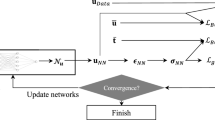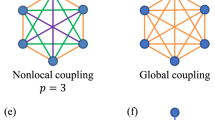Abstract
This paper studies the initial value problem of multi-layer cellular neural networks. We demonstrate that the mosaic solutions of such system is topologically conjugated to a new class in symbolic dynamical systems called the path set (Abram and Lagarias in Adv Appl Math 56:109–134, 2014). The topological entropies of the solution, output, and hidden spaces of a multi-layer cellular neural network with initial condition are formulated explicitly. Also, a sufficient condition for whether the mosaic solution space of a multi-layer cellular neural network is independent of initial conditions is addressed. Furthermore, two spaces exhibit identical topological entropy if and only if they are finitely equivalent.











Similar content being viewed by others
References
Abram, W., Lagarias, J.C.: p-Adic path set fractals and arithemetics. J. Fractal Geom. 1, 45–81 (2014)
Abram, W., Lagarias, J.C.: Path sets in one-sided symbolic dynamics. Adv. Appl. Math. 56, 109–134 (2014)
Adler, R.L., Marcus, B.: Topological entropy and equivalence of dynamical systems. Mem. Am. Math. Soc., vol. 219. AMS: Providence, RI (1979)
Arena, P., Baglio, S., Fortuna, L., Manganaro, G.: Self-organization in a two-layer CNN. IEEE Trans. Circuits Syst. I Fundam. Theory Appl. 45, 157–162 (1998)
Arik, S., Tavsanoglu, V.: Equilibrium analysis of non-symmetric cnns. Int. J. Circ. Theor. Appl. 24, 269–274 (1996)
Ban, J.-C., Chang, C.-H.: On the monotonicity of entropy for multi-layer cellular neural networks. Int. J. Bifur. Chaos Appl. Sci. Eng. 19, 3657–3670 (2009)
Ban, J.-C., Chang, C.-H.: On the structure of multi-layer cellular neural networks. Part II: The complexity between two layers (2012, under review)
Ban, J.-C., Chang, C.-H.: Diamond in multi-layer cellular neural networks. Appl. Math. Comput. 222, 1–12 (2013)
Ban, J.-C., Chang, C.-H.: The learning problem of multi-layer neural networks. Neural Netw. 46, 116–123 (2013)
Ban, J.-C., Chang, C.-H., Lin, S.-S.: The structure of multi-layer cellular neural networks. J. Differ. Equ. 252, 4563–4597 (2012)
Ban, J.-C., Chang, C.-H., Lin, S.-S., Lin, Y.-H.: Spatial complexity in multi-layer cellular neural networks. J. Differ. Equ. 246, 552–580 (2009)
Carmona, R., Jimenez-Garrido, F., Dominguez-Castro, R., Espejo, S., Rodriguez-Vazquez, A.: CMOS realization of a 2-layer cnn universal machine chip. In: Proceedings of the 2002 7th IEEE International Workshop on Cellular Neural Networks and Their Applications, 2002, (CNNA 2002), pp. 444–451 (2002)
Chua, L.O.: Cnn: A Paradigm for Complexity, World Scientific Series on Nonlinear Science, Series A, vol. 31. World Scietific, Singapore (1998)
Chua, L.O., Yang, L.: Cellular neural networks: applications. IEEE Trans. Circuits Syst. 35, 1273–1290 (1988)
Chua, L.O., Yang, L.: Cellular neural networks: theory. IEEE Trans. Circuits Syst. 35, 1257–1272 (1988)
Chua, L.O., Shi, B.E.: Multiple layer cellular neural networks: a tutorial. In: Deprettere, E.F., van der Veen, A.-J. (eds.) Algorithms and Parallel VLSI Architectures, pp. 137–168. Elsevier, Amsterdam (1991)
Chua, L.O., Roska, T.: Cellular Neural Networks and Visual Computing. Cambridge University Press, Cambridge, MA (2002)
Crounse, K.R., Chua, L.O.: Methods for image processing and pattern formation in cellular neural networks: a tutorial. IEEE Trans. Circuits Syst. 42, 583–601 (1995)
Crounse, K.R., Roska, T., Chua, L.O.: Image halftoning with cellular neural networks. IEEE Trans. Circuits Syst. 40, 267–283 (1993)
Forti, M., Tesi, A.: New conditions for global stability of neural networks with application to linear and quadratic programming problems. IEEE Trans. Circuits Syst. I. Funda. Theory Appl. 42, 354–366 (1995)
Forti, M., Tesi, A.: A new method to analyze complete stability of PWL cellular neural networks. Int. J. Bifur. Chaos Appl. Sci. Eng. 11, 655–676 (2001)
Fukushima, K.: Artificial vision by multi-layered neural networks: neocognitron and its advances. Neural Netw. 37, 103–119 (2013)
Fukushima, K.: Training multi-layered neural network neocognitron. Neural Netw. 40, 18–31 (2013)
Juang, J., Lin, S.-S.: Cellular neural networks: mosaic pattern and spatial chaos. SIAM J. Appl. Math. 60, 891–915 (2000)
Li, X.: Analysis of complete stability for discrete-time cellular neural networks with piecewise linear output functions. Neural Comput. 21, 1434–1458 (2009)
Liang, X.-B., Si, J.: Global exponential stability of neural networks with globally lipschitz continuous activations and its application to linear variational inequality problem. IEEE Trans. Neural Netw. 12, 349–359 (2001)
Lind, D., Marcus, B.: An Introduction to Symbolic Dynamics and Coding. Cambridge University Press, Cambridge, MA (1995)
Murugesh, V.: Image processing applications via time-multiplexing cellular neural network simulator with numerical integration algorithms. Int. J. Comput. Math. 87, 840–848 (2010)
Parry, W.: A finitary classification of topological markov chains and sofic systems. Bull. Lond. Math. Soc. 9, 86–92 (1977)
Peng, J., Zhang, D., Liao, X.: A digital image encryption algorithm based on hyper-chaotic cellular neural network. Fund. Inform. 90, 269–282 (2009)
Savaci, F.A., Vandewalle, Joos, On the stability analysis of cellular neural networks. In: Proceedings, Second International Workshop on Cellular Neural Networks and their Applications, 1992, CNNA-92. IEEE, 1992, pp. 240–245 (1992)
Takahashi, N., Chua, L.O.: On the complete stability of nonsymmetric cellular neural networks. IEEE Trans. Circuits-I. 45, 754–758 (1998)
Török, L., Roska, T.: Stability of multi-layer cellular neural/nonlinear networks. Int. J. Bifur. Chaos Appl. Sci. Eng. 14, 3567–3586 (2004)
Xavier-de Souza, S., Yalcin, M.E., Suykens, J.A.K., Vandewalle, J.: Toward CNN chip-specific robustness. IEEE Trans. Circuits Syst. I Reg. Papers 51, 892–902 (2004)
Yang, Z., Nishio, Y., Ushida, A.: A two layer cnn in image processing applications. In: Proceedings of the 2001 International Symposium on Nonlinear Theory and Its Applicationsm, pp. 67–70 (2001)
Yang, Z., Nishio, Y., Ushida, A.: Image processing of two-layer CNNs \(-\) applications and their stability. IEICE Trans. Fundam. E85–A, 2052–2060 (2002)
Acknowledgments
The authors wish to express their gratitude to the anonymous referees for their careful reading and useful suggestions, which make significant improvements to this work. Ban is partially supported by the National Science Council, ROC (Contract No. NSC 102-2628-M-259-001-MY3). Chang is grateful for the partial support of the National Science Council, ROC (Contract No. NSC 104-2115-M-390-004-).
Author information
Authors and Affiliations
Corresponding author
Appendix: Equivalent Relation for Templates
Appendix: Equivalent Relation for Templates
The essential study of (1) is investigating two-layer cellular neural networks with the nearest neighborhood; namely, \(n = 2\) and \(\mathcal {N} = \{-1, 0, 1\}\). For the clarification of the investigation, we assume that \(a_{-1}^{(1)} = a_{-1}^{(2)} = 0\). Under such condition, (1) is represented as
where \(i \in \mathbb {N}\), \(t \ge 0\), and \(y^{(j)}_i = f(x^{(j)}_i)\) for \(j = 1, 2\). Since, for all i, j, \(|x^{(j)}_i(t)| > 1\) provided t is large enough, the output \(y^{(j)}_i(t)\) is either 1 or \(-1\) after finite time. Hence we omit the time factor in the following discussion.
Suppose \(\mathbf {y} = \left( \begin{array}{ll} y_1^{(2)} y_2^{(2)} y_3^{(2)} \cdots \\ y_1^{(1)} y_2^{(1)} y_3^{(1)} \cdots \end{array} \right) \in \mathbf {Y}\) is a mosaic pattern. For \(i \in \mathbb {N}\), \(y_i^{(1)} = 1\) if and only if \(x_i^{(1)} > 1\). This derives
Similarly, \(y_i^{(1)} = -1\) if and only if \(x_i^{(1)}< -1\). This implies \(y_i^{(1)} = -1\) if and only if
The same argument asserts
and
are the necessary and sufficient condition for \(y_i^{(2)} = -1\) and \(y_i^{(2)} = 1\), respectively. Define \(\xi _1: \{-1, 1\} \rightarrow \mathbb {R}\) and \(\xi _2: \{-1, 1\}^{\mathbb {Z}_{3 \times 1}} \rightarrow \mathbb {R}\) by
Set

That is,

Since two-layer cellular neural networks are locally coupled systems, \(\mathcal {B}^{(1)}\) and \(\mathcal {B}^{(2)}\) represents the basic sets of admissible local patterns of the first and second layer of (23), respectively. The set of admissible local patterns \(\mathcal {B}\) of (23) is then

This is to say, the investigation of the equivalent relation for the templates is identical to the discussion of the equivalent relation for the basic sets of admissible local patterns. The fact that \(y^{(1)}, y_r^{(1)} \in \{-1, 1\}\) indicates \(a^{(1)} + z^{(1)} - 1 = - \xi _1(y_r^{(1)})\) and \(a^{(1)} + z^{(1)} - 1 = \xi _1(y_r^{(1)})\) partition \(a^{(1)}\)-\(z^{(1)}\) plane into 9 regions. More precisely, \(a^{(1)}\)-\(z^{(1)}\) plane is partitioned by
and
Encode these nine regions as [p, q] for \(0 \le p, q \le 2\), then a pair of parameters \((a^{(1)}, z^{(1)}) \in [p, q]\) infers that \((a^{(1)}, z^{(1)})\) satisfies m inequalities in (24) and n inequalities in (25). The relative positions of
and the relative positions of
remain to be determined. The “order” of lines \(a^{(1)} + z^{(1)} - 1 = (-1)^{\ell } \xi _1(y_r^{(1)})\), \(\ell = 0, 1\), in the plane come from the sign of \(a_r^{(1)}\), this demonstrates that the parameter space \(\{(a^{(1)}, a^{(1)}_r, z^{(1)})\}\) is partitioned into \(2 \times 9 = 18\) equivalent regions. (Notably, the order of lines \(a^{(1)} - z^{(1)} - 1 = \xi _1(y_r^{(1)})\) and \(a^{(1)} - z^{(1)} - 1 = - \xi _1(y_r^{(1)})\) is determined seamlessly once the order of \(a^{(1)} + z^{(1)} - 1 = (-1)^{\ell } \xi _1(y_r^{(1)})\) is given.) Namely, any two sets of parameters located in the same region determine the identical basic set of admissible local patterns \({{\mathcal {B}}}^{(1)}\). See Fig. 12a.
In an analogous manner, \(y^{(2)}, y_r^{(2)}, u^{(2)}, u_r^{(2)} \in \{-1, 1\}\) indicates that \(a^{(2)} + z^{(2)} - 1 > - \xi _2(y_r^{(2)}, u^{(2)}, u_r^{(2)})\) and \(a^{(2)} + z^{(2)} - 1 > \xi _2(y_r^{(2)}, u^{(2)}, u_r^{(2)})\) partition \(a^{(2)}\)-\(z^{(2)}\) plane into 81 regions. Encode these regions as [p, q] for \(0 \le p, q \le 8\), then a pair of parameters \((a^{(2)}, z^{(2)}) \in [p, q]\) infers that \((a^{(2)}, z^{(2)})\) satisfies m inequalities in (26) and n inequalities in (27). Furthermore, the order of \(a^{(2)} + z^{(2)} - 1 = \xi _2(y_r^{(2)}, u^{(2)}, u_r^{(2)})\) can be uniquely determined according to the following procedures.
-
(1)
The signs of \(a_r^{(2)}, b^{(2)}, b_r^{(2)}\).
-
(2)
The magnitude of \(a_r^{(2)}, b^{(2)}, b_r^{(2)}\).
-
(3)
The competition between the parameter with the largest magnitude and the others. In other words, suppose \(m_1 > m_2 > m_3\) represent \(|a_r^{(2)}|, |b^{(2)}|, |b_r^{(2)}|\). We need to determine whether \(m_1 > m_2 + m_3\) or \(m_1 < m_2 + m_3\).
This partitions the parameter space \(\{(a^{(2)}, a^{(2)}_r, b^{(2)}, b^{(2)}_r, z^{(2)})\}\) into \(8 \times 6 \times 2 \times 81 = 7776\) regions and each region is associated with a basic set of admissible local patterns (cf. Fig. 12b).
The partition of \(a^{(1)}\)-\(z^{(1)}\) and \(a^{(2)}\)-\(z^{(2)}\) planes. In (a), \(\ell ^{+}_i\) and \(\ell ^-_i\), \(i = 1, 2\), that represent the lines in (24) and (25) have partitioned the \(a^{(1)}\)-\(z^{(1)}\) plane into nine regions. In (b), \(\ell ^{+}_i\) and \(\ell ^-_i\), represent the lines in (26) and (27), ave partitioned the \(a^{(2)}\)-\(z^{(2)}\) plane into nine regions, where \(1 \le i \le 8\)
The above discussion demonstrates the following proposition.
Proposition A.1
Let \(\mathcal {P}_8 = \{(a^{(1)}, a^{(1)}_r, a^{(2)}, a^{(2)}_r, b^{(2)}, b^{(2)}_r, z^{(1)}, z^{(2)})\}\) be the parameter space of (23). There is a positive integer K and unique set of open subregions \(\{P_k\}_{k=1}^K\) satisfying
-
(1)
\(\mathcal {P}_8 = \bigcup _{k=1}^K \overline{P}_k\), where \(\overline{U}\) refers to the closure of U;
-
(2)
\(P_i \bigcap P_j = \varnothing \) if \(i \ne j\);
-
(3)
Templates \(\mathbb {T}, \mathbb {T}^{\prime } \in P_k\) for some k if and only if \(\mathbf {Y}_{\mathbb {T}} = \mathbf {Y}_{\mathbb {T}^{\prime }}\).
Example A.2
Suppose \(a^{(1)}_r < 0\) and \(a^{(2)}_r, b^{(2)}, b^{(2)}_r\) are all positive. Moreover, choose \(a^{(2)}_r, b^{(2)}, b^{(2)}_r\) such that
For instance, \(a^{(1)}_r = -1, a^{(2)}_r = 6, b^{(2)} = 3\), and \(b^{(2)}_r = 2\). Then the position of each line is settled. We number the partitions of \(a^{(1)}\)-\(z^{(1)}\) and \(a^{(2)}\)-\(z^{(2)}\) planes by a pair \([m_{\ell }, n_{\ell }]\), \(\ell = 1, 2\), where \(m_{\ell }, n_{\ell }\) illustrate how many inequalities
are satisfied, respectively. Thus \(0 \le m_1, n_1 \le 2\) and \(0 \le m_2, n_2 \le 8\). Pick \([m_1, n_1] = [1,2]\) and \([m_2, n_2] = [6,4]\), for instance, \(a^{(1)} = 2, z^{(1)} = -0.3, a^{(2)} = 4\), and \(z^{(2)} = 2.5\). It is easy to check that the basic set of admissible local patterns is

Rights and permissions
About this article
Cite this article
Ban, JC., Chang, CH. Solution Structure of Multi-layer Neural Networks with Initial Condition. J Dyn Diff Equat 28, 69–92 (2016). https://doi.org/10.1007/s10884-015-9471-9
Received:
Revised:
Published:
Issue Date:
DOI: https://doi.org/10.1007/s10884-015-9471-9





